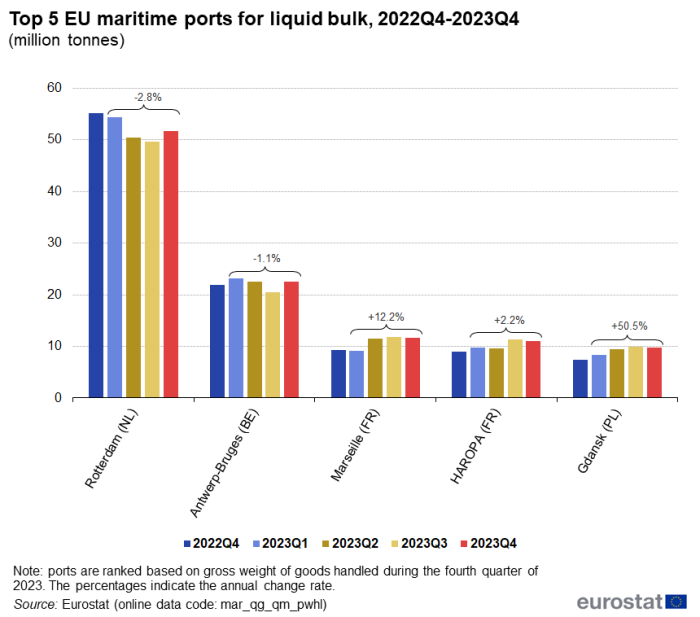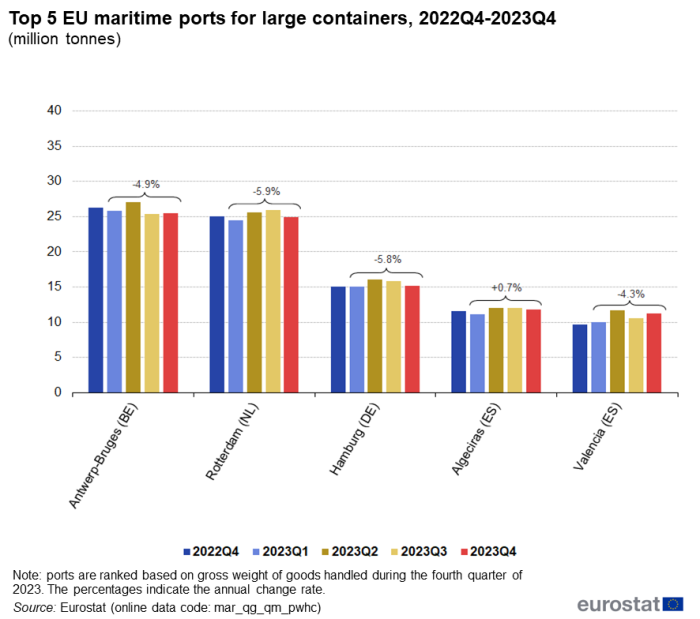Maritime transport of goods at port level - quarterly data
Data extracted in July 2024
Planned article update: 30 October 2024
Highlights
Rotterdam continues to lead the EU in port activity, with 100 million tonnes of goods handled in the fourth quarter of 2023.
This article presents quarterly statistics on maritime transport of goods in the European Union (EU) ports. It covers the gross weight of goods handled in the main EU ports, by type of cargo.
The article contains data for the fourth quarter of 2023. Please note that the quarterly port activity figures are provisional and subject to revision.
Full article
Rotterdam remained the EU port with highest activity in the fourth quarter of 2023
Rotterdam was by far the EU port with the highest activity in the fourth quarter of 2023, with 100 million tonnes of gross weight of goods handled (Figure 1). The second main port was Antwerp-Bruges, which handled 60 million tonnes. These 2 ports decreased in the fourth quarter of 2023 compared with the same quarter of 2022, by 6.1% and 2.1%, respectively. The third port was Hamburg with 24 million tonnes. The fourth and fifth ports were Algeciras and HAROPA, with 20 million tonnes each. These 3 ports increased compared with the same quarter of 2022, by 0.9%, 2.3% and 3.8%, respectively.
When looking at the overall annual change, all ports in the top 5 decreased: Rotterdam by 6.0%, Antwerp-Bruges by 4.7%, HAROPA by 4.2%, Hamburg by 3.6% and Algeciras by 2.1%.
When looking at liquid bulk, Rotterdam was by far the main EU port in the fourth quarter of 2023, followed by Antwerp-Bruges, Marseille, HAROPA and Gdansk (Figure 2). Gdansk and the 2 French ports, Marseille and HAROPA, increased substantially compared with the same quarter of the previous year (+32.0%, +25.0% and +22.8%, respectively). Antwerp-Bruges also increased more moderately by 3.1%. By contrast, Rotterdam fell by 6.3%. When looking at the overall annual change rate compared with the previous period, Gdansk registered the largest increase (+50.5%). Marseille and HAROPA also grew by 12.2% and 2.2%, respectively. By contrast, Rotterdam and Antwerp-Bruges decreased by 2.8% and 1.1%, respectively.

(million tonnes)
Source: Eurostat (mar_qg_qm_pwhl)
When looking at dry bulk, Rotterdam was again the main EU port in the fourth quarter of 2023, followed by Constanta, Amsterdam, Hamburg, and Zeeland Seaports (Figure 3). Compared with the same quarter of 2022, Constanta increased largely by 63.1%. By contrast, the 4 other ports decreased: Amsterdam by 13.3%, Rotterdam by 9.1%, Zeeland Seaports by 6.6% and Hamburg by 0.4%. When looking at the overall annual change rate compared with the previous period, Constanta grew substantially by 27.5%. By contrast, Amsterdam, Zeeland Seaports and Rotterdam substantially fell by 18.3%, 14.6% and 12.2%, respectively. Hamburg also decreased by 1.2%.

(million tonnes)
Source: Eurostat (mar_qg_qm_pwhb)
In the large container cargo segment, Antwerp-Bruges was the main EU port in the fourth quarter of 2023, closely followed by Rotterdam. These 2 ports decreased in the fourth quarter of 2023 compared with the same quarter of 2022, by 2.7% and 0.4%, respectively. This led to overall annual changes of -4.9% and -5.9%. Hamburg, Algeciras and Valencia completed the top 5 EU ports (Figure 4). These 3 ports increased compared with the same quarter of the previous year. The largest growth was registered by Valencia (+17.3%), contrasting with an overall annual change of -4.3%. Algeciras increased by 1.3% compared with the same quarter of the previous year, with an overall annual change of +0.7%. Hamburg also increased compared with the same quarter of the previous year, but more moderately by 0.6%, and showing an overall annual change of -5.8%.

(million tonnes)
Source: Eurostat (mar_qg_qm_pwhc)
When looking at the number of twenty-foot equivalent units (TEUs) handled in the same period (Figure 5), the ranking was slightly different to the one based on tonnes of containerised goods. Indeed, Rotterdam took the first place in front of Antwerp-Bruges and Piraeus took the fourth place, while Algeciras did not appear in the top 5. The first 3 ports decreased in the fourth quarter of 2023 compared with the same quarter of 2022 Antwerp-Bruges (-8.5%), Rotterdam (-4.8%) and Hamburg (-3.8%). By contrast, Valencia and Piraeus increased by 12.4% and 5.1%, respectively. Regarding the overall annual change compared with the previous period, Hamburg recorded the highest decrease (-7.3%), followed by Antwerp-Bruges (-6.7%), Rotterdam (-6.3%) and Valencia (-5.0%). By contrast, Piraeus registered an increase of 8.1%.

(thousand TEUs)
Source: Eurostat (mar_qg_qm_pvh)
When looking at the tonnage of Ro-Ro mobile units, the picture is different compared with the other types of cargo. Antwerp-Bruges was the largest EU Ro-Ro port in the fourth quarter of 2023. It was followed by Rotterdam, Calais, Dublin and Livorno (Figure 6).
Compared with the same quarter of 2022, Calais substantially increased in the fourth quarter of 2023, by 13.5%. By contrast, the 4 other ports decreased. Livorno recorded the highest decrease by 25.2%, followed by Rotterdam (-11.7%), Dublin (-5.8%) and Antwerp-Bruges (-4.3%). When looking at the overall annual change compared with the previous period, all top 5 ports decreased, with the exception of Calais (+8.3%). Livorno decreased substantially by 22.9%, Rotterdam by 8.8%, Dublin by 3.3% and Antwerp-Bruges by 2.8%.

(million tonnes)
Source: Eurostat (mar_qg_qm_pwhr)
Source data for tables and graphs
Data sources and availability
The content of this statistical article is based on data collected within the framework of the EU maritime transport statistics Directive 2009/42/EC on statistical returns in respect of carriage of goods and passengers by sea.
Data are presented at the level of 'statistical ports'. A statistical port consists of 1 or more ports, normally controlled by a single port authority, able to record ship and cargo movements. All figures are based on a port's total (inward + outward) declarations. The results represent the 'handling' of goods in ports.
- Type of cargo: the following thirteen cargo types are used: liquefied gas, crude oil, oil products, other liquid bulk goods, ores, coal, agricultural products, other dry bulk goods, large containers, Ro-Ro mobile units, forestry products, iron/steel products and other general cargo. The first 4 types constitute 'liquid bulk', the subsequent 4 types 'dry bulk' and the last 3 types 'other general cargo not elsewhere specified'.
Abbreviations
| : | not available |
| - | not applicable |
| Nes | Not elsewhere specified |
| Ro-Ro | Roll-on/roll-off |
| TEU | Twenty-foot Equivalent Unit |
Quarterly data are in general provisional. Revisions may be made by countries as more complete information becomes available or as a result of quality checks. More specifically, when the complete set of annual data emerges, this usually involves some revision of quarterly data for some countries.
Annual data as presented in this publication are the rolling 4 quarter totals ending in the latest quarter and the corresponding 4 quarters for earlier years. As a result, the 4 quarters included do not necessarily come from the same calendar year. The 'annual' growth rates show the percentage change for the 4 quarters ending in the third quarter of 2023 compared with the 4 quarters ending in the third quarter of 2022.
The basic results (in million tonnes) and the derived indicators (growth rates) shown in the figures are rounded. However, they are all based on non-rounded original data, as available in Eurostat's database.
Specific remarks for data up to and including the fourth quarter of 2023:
- Starting from 2022Q1, the ports Antwerpen and Zeebrugge have been merged and the data are reported under the new port name Antwerp-Bruges.
- Starting from 2022Q1, the ports Le Havre and Rouen have been merged and the data are reported under the new port name HAROPA.
- Until 2023, data for Sweden include inland waterway transport. The share of inland waterway transport is less than 3% of all goods handled in Swedish ports.
Due to revisions of the underlying data, figures in this article may differ from figures currently or previously available on Eurostat's website.
Context
The content of this statistical article is based on data collected within the framework of the EU maritime transport statistics Directive 2009/42/EC of 6 May 2009 on statistical returns in respect of carriage of goods and passengers by sea, which is a recast of the original Council Directive 95/64/EC of 8 December 1995.
Direct access to
- Transport, see:
- Maritime transport (mar)
- Maritime transport - main annual results (mar_m)
- Maritime transport - short sea shipping - main annual results (mar_s)
- Maritime transport - passengers (mar_pa)
- Maritime transport - goods (mar_go)
- Maritime transport - vessel traffic (mar_tf)
- Maritime transport - regional statistics (mar_rg)
- Maritime transport (ESMS metadata file — mar_esms)
- Reference Manual on Maritime Transport Statistics
- Glossary for transport statistics - 5th edition - 2019
The basic legal act (Directive 2009/42/EC) has been amended by:
- Summaries of EU legislation: Statistical returns in respect of carriage of goods and passengers by sea
- Commission Decision 2010/216/EU of the EP and of the Council of 14 April 2010, OJ L 94, 15.4.2010, p. 33-40
- Regulation (EU) No 1090/2010 of the EP and of the Council of 24 November 2010, OJ L 325, 9.12.2010, p. 1-3
- Commission Delegated Decision 2012/186/EU of 3 February 2012 OJ L 101 of 11.4.2012, p. 5-14.
The following legal acts include the last official version of the list of ports and some dissemination aspects, respectively:
- Commission Decision 2001/423/EC of 22 May 2001 (on dissemination) OJ L 151 of 07.06.2001 p. 41
- Commission Delegated Decision (EU) 2018/1007 of 25 April 2018 supplementing Directive 2009/42/EC of the European Parliament and of the Council as regards the list of ports and repealing Commission Decision 2008/861/EC (Text with EEA relevance.), OJ L 180, 17.7.2018, p. 29–71
